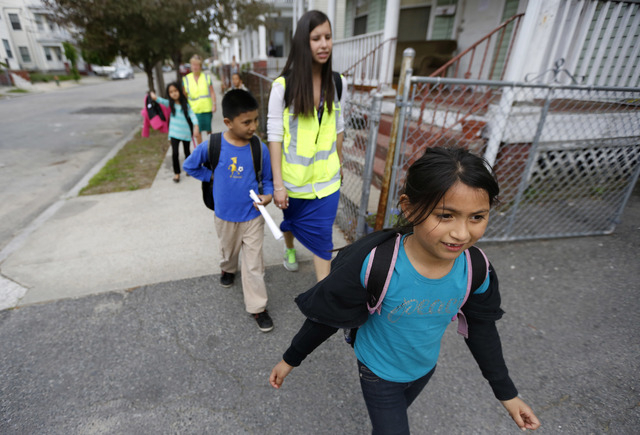Kids, parents embrace the ‘walking school bus’




PROVIDENCE, R.I. — As a group of children walked home together from school in Providence, they held hands and played the “I Spy” guessing game. When they reached a busy intersection, an adult accompanying them prodded, “What’s the rule?”
“Behind the line!” they said in unison, as they stepped back from the edge of the curb and waited for the walk signal.
Shortly after, the group stopped in front of 8-year-old Jaiden Guzman’s house. He said goodbye to his friends and raced to his front door. His mother waved and the rest of the walking school bus continued on its way.
For a growing number of children in Rhode Island, Iowa and other states, the school day starts and ends in the same way — they walk with their classmates and an adult volunteer to and from school. Walking school buses are catching on in school districts nationwide because they are seen as a way to fight childhood obesity, improve attendance rates and ensure that kids get to school safely.
Ten-year-old Rosanyily Laurenz signed up for the Providence walking school bus this school year. Before, she said, she was sometimes late to school when her grandmother didn’t feel well enough to walk with her.
But now, “I get to walk with my friends,” Rosanyily said. “Plus, I get snacks.”
Many programs across the country are funded by the federal Safe Routes to School program, which pays for infrastructure improvements and initiatives to enable children to walk and bike to school.
Robert Johnson, of the Missouri-based PedNet Coalition, a nonprofit that advocates for transit alternatives, said the success of the programs reflects a growing interest in getting kids more active.
“Every parent is looking for ways to make their child a little healthier, and walking to school is one,” he said.
In 2012, about 30 percent of students living within a mile of school walked there in the morning and 35 percent walked home in the afternoon, according to the National Center for Safe Routes to School. Those numbers have increased by about 6 percentage points since 2007.
Organizers in Providence are also motivated by high rates of chronic absenteeism. Thirty-seven percent of Providence students missed 10 percent or more of the 2010-11 school year.
The nonprofit agency Family Service of Rhode Island targeted Mary E. Fogarty Elementary School for its first walking school bus in 2012 because it’s located in one of the city’s poorest neighborhoods. Children who live within a mile of school don’t qualify for the bus.
In Sioux City, Iowa, nearly 1,000 children in 10 elementary schools use walking school buses during the spring and fall, said Alison Benson, spokeswoman for the district. Benson said the program has helped the schools incorporate fitness into the morning routine and build a sense of community.
Elementary schools in Columbia, Missouri, were among the first in the nation to have walking school buses. Piloted in 2003, the program, at its height, involved 450 children, 13 schools and about 200 volunteers. It was canceled this year because of funding issues, according to the PedNet Coalition.
Johnson said he is working with 15 school districts in Kansas on what may become the largest walking school bus project in the United States.
Some districts have been able to cut school bus routes and save money because of the program, he said.
On the milelong route in Providence, the program’s manager, Allyson Trenteseaux, and another volunteer recently led Jaiden, Rosanyily and six other children through busy intersections and around broken glass littering the sidewalks.
On the walks, Trenteseaux said, she mends relationships among the kids, builds relationships and intervenes when there are problems. During the winter, a walk leader noticed some of the children were wearing slippers and bought them all boots.
Last year, 11 of the 14 students who participated and completed a survey attended school more often. The program now has a waiting list, and Family Service plans to expand into more schools next year.












